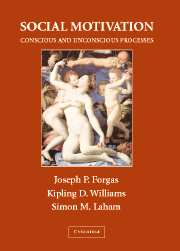Book contents
- Frontmatter
- Contents
- About the Editors
- List of Contributors
- Preface
- The Sydney Symposium of Social Psychology series
- 1 Social Motivation: Introduction and Overview
- PART I CONSCIOUS AND UNCONSCIOUS SOCIAL MOTIVATION: GENERAL ISSUES
- 2 Multiple Goals, Optimal Motivation, and the Development of Interest
- 3 The Machine in the Ghost: A Dual Process Model of Defense Against Conscious and Unconscious Death-Related Thought
- 4 Habits and the Structure of Motivation in Everyday Life
- 5 Motivation in Social Settings: Studies of Effort-Related Cardiovascular Arousal
- 6 Reflection and Impulse as Determinants of Conscious and Unconscious Motivation
- 7 The Role of Motivation in the Unconscious: How Our Motives Control the Activation of Our Thoughts and Shape Our Actions
- PART II SOCIAL MOTIVATION: COGNITIVE AND AFFECTIVE IMPLICATIONS
- PART III CONSCIOUS AND UNCONSCIOUS SOCIAL MOTIVATION: SOME CONSEQUENCES AND APPLICATIONS
- Author Index
- Subject Index
- References
6 - Reflection and Impulse as Determinants of Conscious and Unconscious Motivation
Published online by Cambridge University Press: 04 August 2010
- Frontmatter
- Contents
- About the Editors
- List of Contributors
- Preface
- The Sydney Symposium of Social Psychology series
- 1 Social Motivation: Introduction and Overview
- PART I CONSCIOUS AND UNCONSCIOUS SOCIAL MOTIVATION: GENERAL ISSUES
- 2 Multiple Goals, Optimal Motivation, and the Development of Interest
- 3 The Machine in the Ghost: A Dual Process Model of Defense Against Conscious and Unconscious Death-Related Thought
- 4 Habits and the Structure of Motivation in Everyday Life
- 5 Motivation in Social Settings: Studies of Effort-Related Cardiovascular Arousal
- 6 Reflection and Impulse as Determinants of Conscious and Unconscious Motivation
- 7 The Role of Motivation in the Unconscious: How Our Motives Control the Activation of Our Thoughts and Shape Our Actions
- PART II SOCIAL MOTIVATION: COGNITIVE AND AFFECTIVE IMPLICATIONS
- PART III CONSCIOUS AND UNCONSCIOUS SOCIAL MOTIVATION: SOME CONSEQUENCES AND APPLICATIONS
- Author Index
- Subject Index
- References
Summary
INTRODUCTION
Social behavior may be determined by both conscious and unconscious forces. Indeed, a first look at the dominant theories of motivation (Higgins & Kruglanski, 2000) suggests that this distinction lends itself to a meaningful classification of motivational mechanisms. Conscious accounts are based on the assumption that humans (and to some degree other primates) are endowed with reason and insight. What they do can therefore be construed as deliberate action, the mental precursor of which is a decision or a choice. As Ajzen (1996, p. 298) has put it, acting “involves a choice even if the alternative is no action.” It is therefore useful to study people's reflective judgments as precursors to their choices. Specifically, decisions are based on the perceived value of the outcomes of an action and the subjective probability that they can be achieved. This expectancy-value perspective has influenced many theoretical approaches (for a review, see Feather, 1982). Most prominently, perhaps, Fishbein and Ajzen's theories of reasoned action (Ajzen & Fishbein, 1980) and of planned behavior (Ajzen, 1991) have invoked this model to specify the influence of attitudinal judgments on human behavior. Also, Bandura's (1977) theory of social learning has adopted central elements of the expectancy-value paradigm.
Another variant of the conscious approach to motivation invokes people's intentions in the context of goal pursuit (see also Aarts & Hassin, this volume). Specifically, actors are assumed to intentionally control and regulate their behavior in order to reach a specific end state.
Information
- Type
- Chapter
- Information
- Social MotivationConscious and Unconscious Processes, pp. 91 - 112Publisher: Cambridge University PressPrint publication year: 2004
References
Accessibility standard: Unknown
Why this information is here
This section outlines the accessibility features of this content - including support for screen readers, full keyboard navigation and high-contrast display options. This may not be relevant for you.Accessibility Information
- 5
- Cited by
